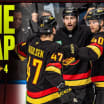Drafting and developing are the two critical elements in establishing a strong prospect pipeline.
You can make the argument that who you draft is more important, but the Canucks development team believes that how you support your draft picks in development is paramount.
Both play an integral role in how to bring young, talented players to your NHL club. Over the past couple of seasons, Mikael Samuelsson and Mike Komisarek have become fundamental pieces on the development side of the prospect-building spectrum.
We sat down with the development duo, who have a combined 1,250 games of NHL experience and a ton of respect in the NCAA and European pro hockey circles.
Komisarek joked that most Swedes know Samuelsson when they start working together, but both development coaches want to make a good impression on these kids to tell them they are here to help.
“We want them to know that we are in their corner and we want their best, that's it,” said Samuelsson. “It's not going to matter what we did when we played the game. We need to prove ourselves to the players in our development roles.”
Both Samuelsson and Komisarek know about the journey, and they both experienced very different paths to get to the NHL.
Komisarek was selected 7th overall in the 2001 NHL Entry Draft while Samuelsson went 145th in 1998. The two players experienced diverse paths to the NHL from very different starting spots but both were able to make it to the final destination and be successful in their journeys.
Komisarek went through the United States National Team Development Program before a couple of years at the University of Michigan and then three years between the NHL and AHL before he found his spot as an everyday NHLer with the Montreal Canadiens in 2005.
Samuelsson played a full two seasons of pro hockey in Sweden after he was drafted and then spent a season in the AHL before he made the jump to being a full-time NHL player in 2001.
It was interesting to ask what the development coach duo enjoy so much about their jobs. They believe these young players possess a ton of talent but can benefit from guidance on their path to professional hockey.
“For us, it's so exciting to be on the day-to-day journey with these players,” said Komisarek. “We’re filling the void of where they have deficiencies. They're exposed to so much from their coaches back home and we're coming in and we're helping them navigate the ups and downs, the adversities, and are helping them add different layers to the game. We're cheering for them all like we do for our own kids. The goal is to not have these guys play for 10-15 NHL games but have meaningful, impactful careers as a Canuck on a Stanley Cup-winning team.”
We heard a similar response from Samuelsson, who emphasizes the person as much as he does the player.
“Just to see young, raw talent that maybe could develop into the best version of themselves. That's what's so cool about it. That's on the ice anyways, but it's also on a personal level. For me, it's almost leaning towards the personal level. Because if you don't engage them there, you can send all the messages in the world - and great messages for the most part - but it doesn’t mean the same without the connection. The personal level is what triggers me. It starts outside the rink or away from the ice and from there, it converts to on the ice.”
Samuelsson typically begins his interactions with prospects with the same question.
He asks the player, ‘How good do you want to become?’. From there, Samuelsson helps these young men build a plan and try to present habits such as: how to behave, how to eat, how to time sleep, and other tips on how to become a pro.
Prospects will often speak about Samuelsson and Komisarek sending video, coming to their games, or just catching up for a meal to chat. It’s about building the relationship and growing trust between the two parties and the prospects do nothing but gain from learning from pros like Komisarek and Samuelsson.
The development staff is a worldwide crew, and they catch up every week to check in on every prospect that they are working with. Daniel and Henrik Sedin, Cammi Granato, Ryan Johnson, and Chris Higgins are typically involved in these weekly meetings but can be joined by Patrik Allvin or Émilie Castonguay to share ideas.
Everyone has such valuable input,” said Komisarek. “We're discussing the plan and process that these kids need to go through to give them success. We're sharing ideas in these meetings because there's no one-size-fits-all for prospects and we're always cultivating our message or approach or process with these kids.
The ultimate goal of the development staff is to implement Canucks hockey into these young players’ DNA. They want to prepare players to practice, act, and play like Canucks. There’s an expectation for the person as much as there is for the player.
“We're always massaging the message,” said Samuelsson. “We always have that long-term vision of where these guys want to be and where they could be. Helping them realize their potential is the most work but also the most rewarding.”
Development is difficult because it is not linear.
Stats don’t mean much because at these young players’ age, it’s so much more about the process.
“If you want to go fast, go alone, but if you want to go far, go together,” said Samuelsson about a player focusing on putting up goals and assists. “If you simply look at the points and think that's the most important, that tells me that you don't understand how to create or be on a successful team."
“We don't worry about the points,” said Komisarek. “It's great, but we've seen it tons of times where players are getting something like a goal and three assists, but they didn't necessarily have the best game. We like to look at how they impact the game because, at the next level, that's going to be the thing that is tested on a consistent basis.”
The development team works closely with the analytics staff and utilizes data and progression in a player's game. They try to use that data to show players how they can be more efficient and what is going to help them get to the next level.
Obviously, the main focus of the development staff is to prepare players for the NHL but both Samuelsson and Komisarek have to prepare players for difficult transitions such as coming to North America or making the jump from CHL or NCAA to pro hockey.
With Abbotsford just down the road, it gives the Sedins, Jeff Ulmer, Gary Agnew, Marko Torenius and Jeremy Colliton a chance to show that they can help guide these young players in their final step toward the NHL. Utilizing the proximity of the AHL team is something we have written about many times here on the site and we are beginning to see some of the fruits of that labour with guys like Nils Höglander, Nils Åman, and Noah Juulsen being successful NHLers after developing their game in Abbotsford.
“The NHL is where we want all our prospects to end up,” said Samuelsson. “To help the Canucks to make the playoffs and make a run for the cup. Our main goal is to get them in there. The habits, environment, things like that. It's so much more important than points, that's one of our challenges -- for the players to understand that.”
“That's the tricky part,” Samuelsson continued. “Some players might ask ‘Why do I have to do these things? Because I still put up a lot of points'. We just know that if they take the next step up to Abbotsford for example, they will have a tough time to be good at that level without the right habits in their game.”
Development is something that anyone can work on and it’s something that both Komisarek and Samuelsson are continuing to learn in their post-playing careers. Komisarek has learned a lot about how to reach a player through getting to know the person.
He speaks highly of how face-to-face interaction is so important and how the Canucks summer development camp is a tremendous opportunity for the prospects to all meet each other while the development staff gets a chance to lock in with these prospects for a week and give them the tools to take home and develop their game on their own.
Samuelsson is learning patience with his young players but does have some pillars with how a player takes advice.
“If I send a message the first time they screw something up and they don't get it the first time, it's fine for me,” said Samuelsson. “When it comes to habits, though... If I send the same message a couple of times and still, the player doesn't get it, that's when I start to get a little frustrated. I think ‘Okay, I need to change my tactics’ and take a different approach. It comes down to the individual. I will be patient with them for a while. But if I don't see progress. I realize that to do a good job, I need to do something else and change my approach.”
Komisarek and Samuelsson are here to help these young people develop their skills but also develop into men. It’s very difficult for a teenage kid to move from Sweden to North America, an NCAA player to adjust to life without school, or a 20-year-old to prepare for how different pro hockey is from junior hockey.
That’s a big part of the development staff and they want to help make a difference in these young people’s lives.
“At the end of the day, you can tell these kids whatever you want but they need to know that you care about that human side,” said Komisarek. “Whether you played 1000 NHL games, or you barely played, if you don't have that trust and the kid doesn't have the belief that you care about them -- it's tough to accomplish anything together.”
Expect Samuelsson and Komisarek to evolve in their roles with the development staff and will make a difference in these players’ game with the assistance of Ryan Johnson, Cammi Granato, Daniel Sedin, Marko Torenius, Jeremy Colliton, Henrik Sedin, Chris Higgins, and more.
This organization is committed to assisting the prospects however they can and having a variety of life experiences around the game help provide a safe environment for the prospects to ask questions and be able to learn about the next stages of their lives. The pieces are in place all around the world to provide assistance and be there when a player requires guidance or is experiencing something new in their career.
In the end, drafting and developing are both important but the difference is the return that you get from development seems to be just about as much for the person as it is for the player.
And that’s great to see.



















